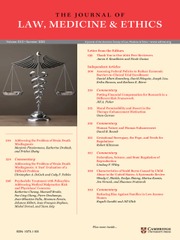No CrossRef data available.
Article contents
Grappling with Judicial Discretion in Complex Times
Published online by Cambridge University Press: 15 September 2025
Abstract
When areas of the law are ambiguous or untested, such as in the compassionate release cases that proliferated during the height of the COVID-19 pandemic, district judges must rely on their discretion to fill in legal gaps. Discretion can be beneficial, because it means that it allows district judges to consider factors that may lead to potentially harmful outcomes for litigants or their communities. But discretion is imperfect, particularly in the face of ethically or factually complex problems. Perhaps a place to start with addressing this difficulty is greater transparency about the benefits and limitations of discretion.
Information
- Type
- Commentary
- Information
- Journal of Law, Medicine & Ethics , Volume 53 , Issue 3: Public Health, Markets, and Law , Fall 2025 , pp. 433 - 434
- Copyright
- © The Author(s), 2025. Published by Cambridge University Press on behalf of American Society of Law, Medicine & Ethics
References
Posner, E.A. and Saran, S., “Judge AI: Assessing Large Language Models in Judicial Decision-Making,” University of Chicago Coase-Sandor Institute for Law & Economics Research Paper No. 25-03 (January 2025), at 1, http://doi.org/10.2139/ssrn.5098708.CrossRefGoogle Scholar
Spamann, H. and Klöhn, L., “Justice is Less Blind, and Less Legalistic, than We Thought: Evidence from an Experiment with Real Judges,” Journal of Legal Studies 45, no. 2 (2016): 255–280, https://doi.org/10.1086/688861.CrossRefGoogle Scholar
Spamann, H. and Klöhn, L., “Can Law Students Replace Judges in Experiments of Judicial Decision-Making?” Journal of Law & Empirical Analysis 1, no. 1 (2024): 149–161, https://doi.org/10.1177/2755323X231210467.CrossRefGoogle Scholar
See Posner & Saran, supra note 1, at 22.Google Scholar
See Posner & Saran, supra note 1, at 26.Google Scholar
See Posner & Saran, supra note 1, at 18.Google Scholar
See Posner & Saran, supra note 1, at 18.Google Scholar
See Posner & Saran, supra note 1, at 26.Google Scholar
See Posner & Saran, supra note 1, at 28.Google Scholar
Mooney, H., Larkin, K., and Howard-Williams, M., “Compassionate Release and COVID-19: Analyzing Inconsistent Applications of the First Step Act by Federal Courts,” Journal of Law, Medicine and Ethics 53, no. 3: 426–432, https://doi.org/10.1017/jme.2025.10127.Google Scholar
Compassionate Release: The Impact of the First Step Act and COVID-19 Pandemic (US Sentencing Commission, March 2022), https://www.ussc.gov/research/research-reports/compassionate-release-impact-first-step-act-and-covid-19-pandemic.Google Scholar
US v Pena, 459 F.Supp.3d 544, 547–548 (S.D.N.Y. 2020).Google Scholar
US v. Thompson, 984 F.3d 431 (5th Cir. 2021).Google Scholar
US v. Thompson, at 435.Google Scholar
Ryckman, T. et al., “Outbreaks of COVID-19 variants in US prisons: a mathematical modelling analysis of vaccination and reopening policies,” Lancet Public Health 6, no. 10 (2021): E760–E770, https://doi.org/10.1016/S2468-2667(21)00162-6.CrossRefGoogle ScholarPubMed
“Yes, court bias exists – and judges must attack it,” American Bar Association, Feb. 11, 2022, https://www.americanbar.org/news/abanews/aba-news-archives/2022/02/yes-court-bias-exists-and-judges-must-attack-it/Google Scholar
“Defending the Judiciary,” Duke Law: Bolch Judicial Institute, https://judicialstudies.duke.edu/defending-the-judiciary/.Google Scholar

